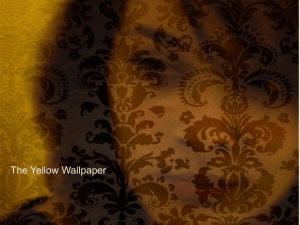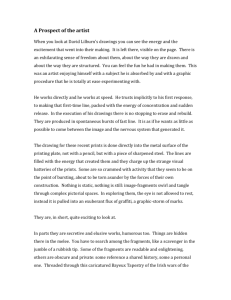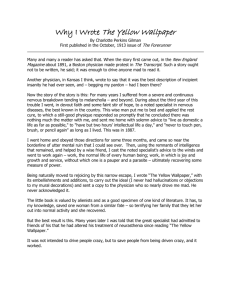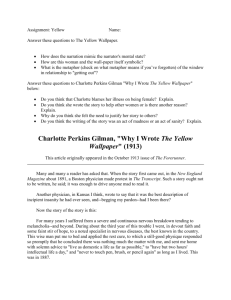Dangerous Beauty
advertisement
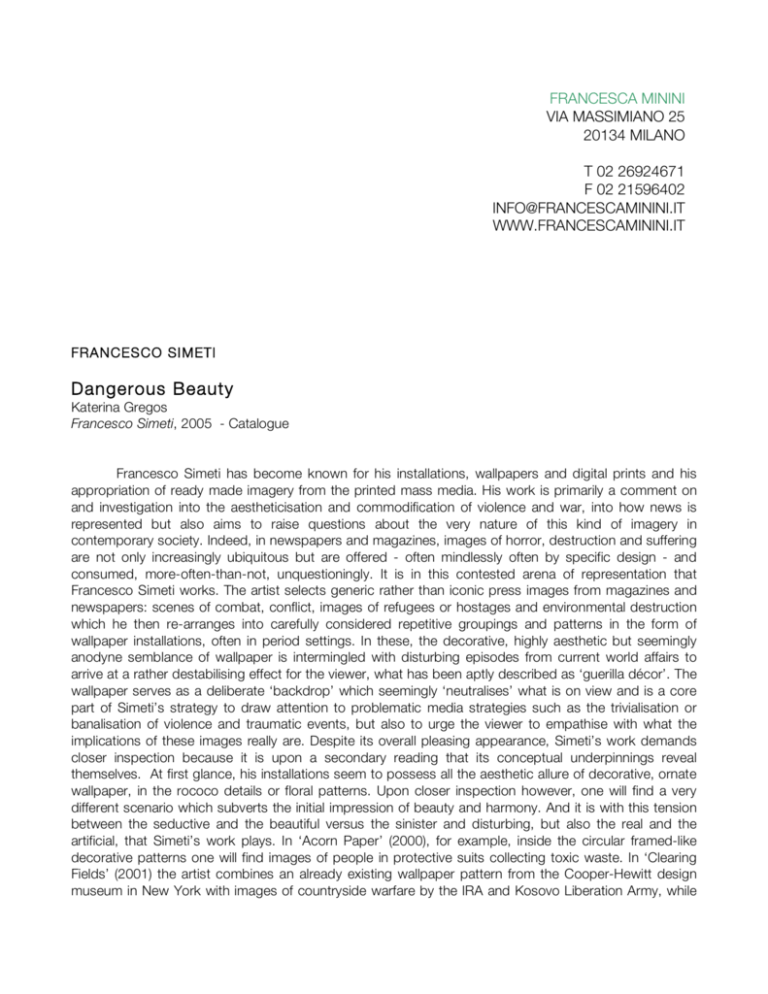
FRANCESCA MININI VIA MASSIMIANO 25 20134 MILANO T 02 26924671 F 02 21596402 INFO@FRANCESCAMININI.IT WWW.FRANCESCAMININI.IT FRA NCES CO SI M ETI Dangerous Beauty Katerina Gregos Francesco Simeti, 2005 - Catalogue Francesco Simeti has become known for his installations, wallpapers and digital prints and his appropriation of ready made imagery from the printed mass media. His work is primarily a comment on and investigation into the aestheticisation and commodification of violence and war, into how news is represented but also aims to raise questions about the very nature of this kind of imagery in contemporary society. Indeed, in newspapers and magazines, images of horror, destruction and suffering are not only increasingly ubiquitous but are offered - often mindlessly often by specific design - and consumed, more-often-than-not, unquestioningly. It is in this contested arena of representation that Francesco Simeti works. The artist selects generic rather than iconic press images from magazines and newspapers: scenes of combat, conflict, images of refugees or hostages and environmental destruction which he then re-arranges into carefully considered repetitive groupings and patterns in the form of wallpaper installations, often in period settings. In these, the decorative, highly aesthetic but seemingly anodyne semblance of wallpaper is intermingled with disturbing episodes from current world affairs to arrive at a rather destabilising effect for the viewer, what has been aptly described as ‘guerilla décor’. The wallpaper serves as a deliberate ‘backdrop’ which seemingly ‘neutralises’ what is on view and is a core part of Simeti’s strategy to draw attention to problematic media strategies such as the trivialisation or banalisation of violence and traumatic events, but also to urge the viewer to empathise with what the implications of these images really are. Despite its overall pleasing appearance, Simeti’s work demands closer inspection because it is upon a secondary reading that its conceptual underpinnings reveal themselves. At first glance, his installations seem to possess all the aesthetic allure of decorative, ornate wallpaper, in the rococo details or floral patterns. Upon closer inspection however, one will find a very different scenario which subverts the initial impression of beauty and harmony. And it is with this tension between the seductive and the beautiful versus the sinister and disturbing, but also the real and the artificial, that Simeti’s work plays. In ‘Acorn Paper’ (2000), for example, inside the circular framed-like decorative patterns one will find images of people in protective suits collecting toxic waste. In ‘Clearing Fields’ (2001) the artist combines an already existing wallpaper pattern from the Cooper-Hewitt design museum in New York with images of countryside warfare by the IRA and Kosovo Liberation Army, while in ‘Watching the War’ (2002), the artist fuses images from the war in Afghanistan with beautifully arranged images of explosions and their resulting ‘clouds’. Simeti is primarily concerned with the way we consume images and information through the media but also how these are ‘framed’ aesthetically and contextually. At the same time his work points to changing geopolitical conditions in the world and is a direct comment on the current culture of fear and war-mongering which is being propagated by some governments and media conglomerates alike. Now I Know my ABCs, Next Time Won’t You Sing with Me?, for example, is a series of 26 prints (in two versions, 2002 and 2003) where Simeti presents a pictorial alphabet for children. Here each letter is visualized by a picture and a word that goes with it as in any child's book of ABC’s, except that Simeti’s images and words are in contrast with the idea that we all have from our childhood about a pictorial alphabet. Simeti’s ABC’s are neither innocent nor rosy; rather they present a very dystopic view of the present, one which is steeped with the reality but also fear of war. This is an alternative alphabet for 21st century children, through which they can be taught the ‘necessary’ semantics of warfare. So instead of ‘C’ for cat and ‘D’ for dog, in Simeti’s alphabet one will find ‘C’ representing ‘cluster’, ‘D’ for dungeon and ‘B’ for bazooka. This work alone speaks heaps of the changed global status quo in the aftermath of 9/11. If Now I Know my ABCs… ground the viewer in a matter-of-fact pragmatism Artificio (2003-4), on the other hand, possesses a deliberately more sensationalist visual quality but is also more ambiguous in its message. The work is a series of glossy, vibrantly colourful digital prints of explosions, which are not necessarily recognisable as such. The title of each image works as an ambiguous hint by referencing the caption of the newspaper giving out the location of the explosion or the name of the bomb. The title, of course, means artifice in Italian, but is also a play on words since fire works are called ‘fuochi d’ artificio’ (artificial fires). The ambiguity of what is on view and the difficulty of defining the genealogy of the images is what Simeti plays with here. Indeed the works hover between beauty and horror, between the realistic and the simulated, leaving the viewer in apprehension as to their origin and resting more on their sheer power of association. At the same time, they retain the iconic status and spectacular quality of their typology though attempts to ‘place’ or ‘categorise’ these images are ultimately frustrated. In his most recent work, ‘Garlands’ (2005), made especially for the exhibition at Vitamin Gallery, Simeti combines the printed image with sculptural elements. The installation is a kind of hybrid between a hunting pavilion and a fake grotto. There is a wallpaper with repeating prints of helicopters and a cave (a reference to Osama Bin Laden), plaster casts of branches and sticks, plastic camouflage branches, a sculpture of a bear made out of papier maché decorated with floral patterns (modelled on 3D shooting targets available in hunting catalogues) and a series of ‘portraits’ of men modelling camouflage suits taken from hunting and paramilitary equipment catalogues. As with many of his previous works, there is a contradictory duality to this work, a tension between the real and the artificial, the ‘natural’ and the contrived, in conceptual as well as visual terms. There is also, just to mention an example of one of the installation’s references, something uncanny but also ridiculous about men who use plastic camouflage branches and paraphernalia to venture into real nature, in order to shoot and kill, whether for hunting or combat purposes. In all these works Simeti deliberately emphasises the formal aspects of the individual images he culls from the media, in an attempt to draw attention to the fact that journalistic photography and reportage (not to mention advertising) is becoming, itself, increasingly ‘artistic’ - in some perverse, odd sense. All of the artist’s practice concentrates on the ever-pervasive power of the media image, a power that often usurps the message itself. On the other hand, Simeti is well aware that notions of advertising, marketing and graphic design are increasingly infiltrating into ‘serious’ journalism, and he uses the very same tactics in his own work as a subversive tool in order to draw attention to and expose these kinds of mechanisms. However, the concept of design, in Simeti’s work is not delivered with the same punch and in-your-face manner as in the work of Barbara Kruger, for example. Rather, Simeti opts for a quieter, insidious, more ‘camouflaged’ approach – visually as well as conceptually - where the message lies in the details, in the in-between areas of what is represented. Simeti’s tactics can be summed up in three words: aestheticise, disguise, destabilise. These are achieved by his ability to subvert a given system by using its own language and strategies in order, ultimately, to draw attention to its problematics and mechanisms of representation. In this way, he comments not only on the aestheticisation of violence but also on the way in which the media often reduce horrific events to trivial, expendable incidents. In pictorial terms, he intimates the manner by which such events are reduced to media sound bites or background “noise”. Simeti’s work, however, is not concerned with offering definitive answers about the issue of media representations. Nor does he adopt a moral stance; that is something that is left to the viewer. Instead his work is more concerned with asking questions and with conveying the message that images should not be taken at face value, and more importantly perhaps, that what one sees is not always necessarily what one gets.
